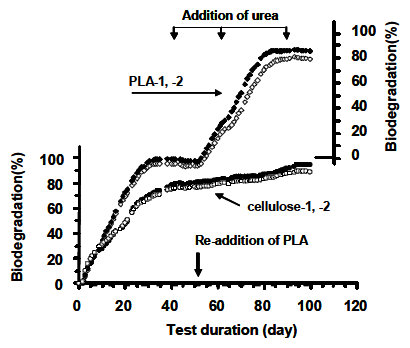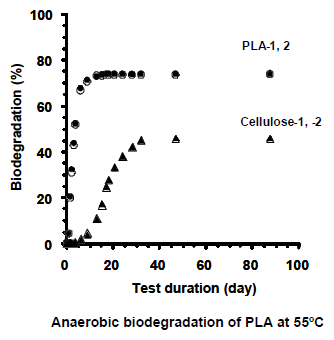System principle
〔MODA-9, -6, -4(aerobic system)〕
- Samples are degraded in active compost through which air is passed under controlled conditions. The evolved ammonia and water are removed and the evolved carbon dioxide is absorbed by soda lime (sodium hydroxide). Evolved carbon dioxide is calculated from the weight increase of the soda lime.
- Reaction columns can be controlled at a user-specified temperature. If following ISO14855-2, the temperature is typically held at 58 deg..
- Samples are weighed periodically during the test period.
- According to ISO14855-2, evaluation of biodegradability requires three tests:
- compost only (blank)
- compost mixed with a standard (cellulose)
- compost mixed with the sample of interest.
- The results obtained by MODA are recognized as reproducible.

Fig.1 Principle of MODA-9, -6, -4

Fig.2 Experiments on aerobic biodegradation of PLA by MODA
〔MODA-B(anaerobic system〕
- Determination of test material biodegradability by evolved biogas
- Wet methane fermentation in slurry phase
(TS* < 15%)
*TS = total solids (%) = 100 – W (W = % moisture content) - Volume of test mixture from 1.0 – 1.5 L
- Number of samples: 6
- 2x test material
- 2x reference
- 2x blank samples compared simultaneously
- Fermentation at thermophilic temp.: 55 deg.
- Fermentation at atmospheric pressure
- Measurement of evolved biogas by a syringe or gas burette
- Amount of test materials: 10 g

Fig. 3 Principle of MODA-B

Fig. 4 Anaerobic biodegradation of PLA at 55℃
Background
In this century, people are starting to try to establish environment-friendly society to balance human society with global environment.
Especially packaging material, disposed packages are becoming one of the major reasons giving negative impact to global environment.
Chemical engineers are trying to develop plastic materials which can be biodegaraded under various conditions such as compost, soil, aqueos or anaerobic digestion under activated sludge condition.
The plastics that global society hopes are not ‘disintegrated’ just only small and fine but should be ‘biodegraded’ to carbon dioxide and water at aerobic, and to .methane and carbon dioxide at anaerobic condition completely. *refer the article by Dr.Narayan in vol.5 of ‘bioplastics MAGAZINE, page 38.
Standard
“Biodegaradability” as International Standard
To avoid misuse or misunderstanding about “Biodegradability”, it is necessary to have the unified test procedure which is as of international standard when using the word “biodegarable” to a plastic product.
For example, with applying the test procedure of ISO14855-2:2007*1, PLA is proven as biodegradable plastic that is biodegraded more than 90% after 45 days at 58℃ under compost condition(refer fig.1). In this way PLA became to be one of the most recognized biodegradable plastics in the world.
ISO14855-2 and MODA apparatus
In this “biodegradable” testing field, ISO14855-1:2005*2 (ASTM5338-11*3, EN14046:2003*4) was one of the well understood procedures, that is aerobic biodegradable test under compost condition, but the procedure was difficult to reproduce over 70% biodegradation of cellulose in Japan.
To make the reason clear and to find out the solution, National project started about 10 years ago to develop apparatus and test procedure by the leadership of JBPA(Japan Bioplastic Association) with the cooperation of AIST(National Institute of Advanced Industrial Science and Technology) and several universities.
As a result of various testings done, microbial activity under matured compost conditions depends on water content of compost was found. But also found, to keep appropriate water content level for long time was very difficult too.
Because European matured composts have little volatile ingredient, it can get sufficient microbial activation for biodegradability testing with little water, on other hand, Asian matured composts include Japanese one have much volatile ingredients, by this existence of much volatile ingredients, microbial activation by water become short and microbial activation decreased.
Adding sea sand or vermiculite to mature compost makes the concentration of volatile material to dilute, to keep the water holding capacity at appropriate level, test results became almost same as the test results done in European countries.
In addition to it, with designing apparatus so called “MODA : Microbial Oxidative Degradation Analyzer”, we could succeeded in reducing the amount of compost to 1/10 of test material specified in ISO14855-1 by introducing precise “Gravimetric Procedure” to measure the CO2 generated.
Based on the original MODA apparatus, we, Saida FDS, developed MODA-6 apparatus for which we introduce environmental chamber keeping 6 reaction units in it to keep temperature condition same and water content level more appropriate.
This MODA was originally designed to do testing under compost condition, but considered applicable to soil condition also, we have started testing using MODA apparatus for biodegradability testing under soil condition that is standardized as ISO17556.
Outline of Standards for Biodegradable Plastic(PDF:14.3KB)
Papers related to MODA
- Biodegradability Evaluation of Polymers by ISO 14855-2, Masahiro Funabashi, Fumi Ninomiya, Masao Kunioka, International Journal of Molecular Science, 2009,10,3635-3654.
(https://www.ncbi.nlm.nih.gov/pmc/articles/PMC2812819/) - The effect of Thai compost on biodegradability of polylactic acid baced on ISO 14855-2 method, W.Timbuntam, S.Pongsomnam, V.Vanichsriratana, P.Sukyai, Advanced Marerials Research, 2011, Volumes 415-417, 2184-2190.
(https://www.scientific.net/AMR.415-417.2184) - Measure Biodegradability of Plastics More Accurately, F.Castellani, A.Esposito, V.Stanzione, R.Altieri, Advances in Materials Science and Engineering, 2016, Article ID 6909283, 7 pages.
(https://www.hindawi.com/journals/amse/2016/6909283/) - Carbon transformatikons by attached bacterial populations in granitic groundwater from deep crystalline bed-rock of the Stripa research mine, S.Ekendahl, K.pedersen, Microbiology, 1994, 140(Pt7), 1565-1573
(https://www.ncbi.nlm.nih.gov/pubmed/8075798) - Anaerobic Biodegradation Tests of Poly(lactic acid) under Mesophilic and Thermophilic Conditions Using a New Evaluation System for Methane Fermentation in Anaerobic Sludge, H.Yagi, F.Ninomiya, M.Funabashi, M.Kunioka, International Journal of Molecular Science, 2009, 10(9), 3824-3835.
(https://www.ncbi.nlm.nih.gov/pmc/articles/PMC2769157/) - BIOPLASTICS: TECHNOLOGY PRINCIPLES AND EXEMPLARS, R.Narayan, Society of Plastics Engineers Global Plastics Environmental Conference, 2007.
- Biodegradability…Sorting through Facts and Claims, R.Narayan, bioplastics MAGAZINE, 2009, [01/09], Vol.4, 28-31.
(https://bpiworld.org/resources/Documents/Narayan%20Bioplastics%20Article%202009.pdf) - Anaerobic Biodegradation of Surfactants Scientific Review, J.L.Berna, G.Cassani, C.-D.Hager, N.Rehman, I.Lopez, D.Schowanek, J.Steber, K.Taeger, T.Wind, Tenside Surfactants Detergents,2009, Vol.46, No.1, 53-62
(https://www.hanser-elibrary.com/doi/abs/10.3139/113.100351) - Misleading Claims and Misuse of Standards Continues to Proliferate in the Nascent BioPlastics Industry Space,R.Narayan, bioplastics MAGAZINE, 2002, [01/10], Vol.5, 38-41.
(https://www.bioplasticsmagazine.com/bioplasticsmagazine-wAssets/docs/download/articles/1001_p38_bioplasticsMAGAZINE.pdf) - ACCURATIVE AND EASY EVALUATION OF AEROBIC MICROBIAL-DEGRADABILITY OF BIODEGRADABLE PLASTICS UNDER CONTROLLED SOIL, S.Uematsu, A.Murakami, K.Hiyoshi, Y.Tsukamoto, H.Saida, M.Tsuji, A.Hoshino, PolymerPreprints, 2002, 43(2), 930-931.
(https://www.saidagroup.jp/fds_en/wp/wp-content/uploads/2018/10/acs.pdf)
